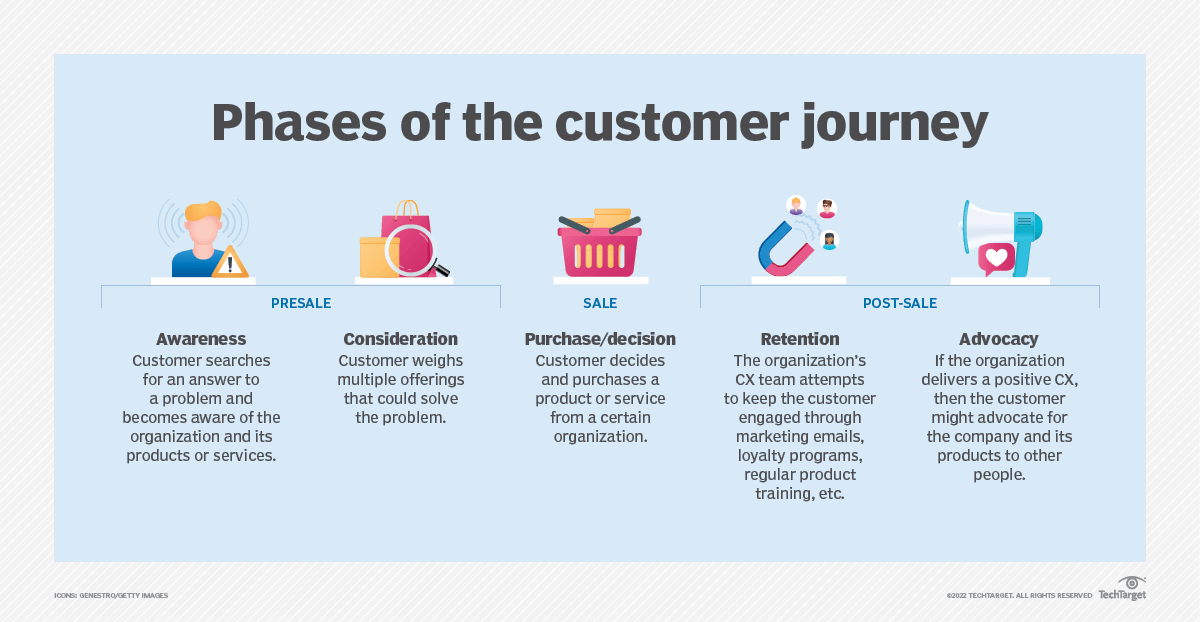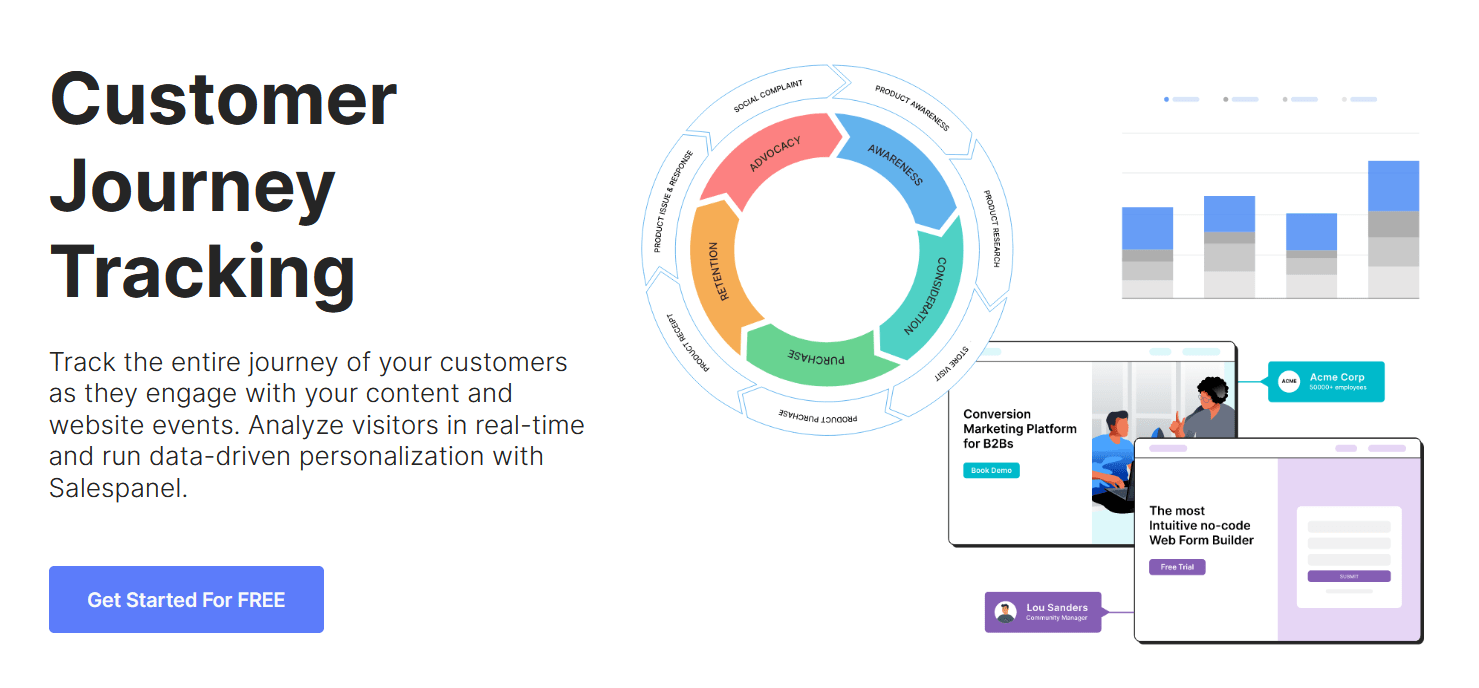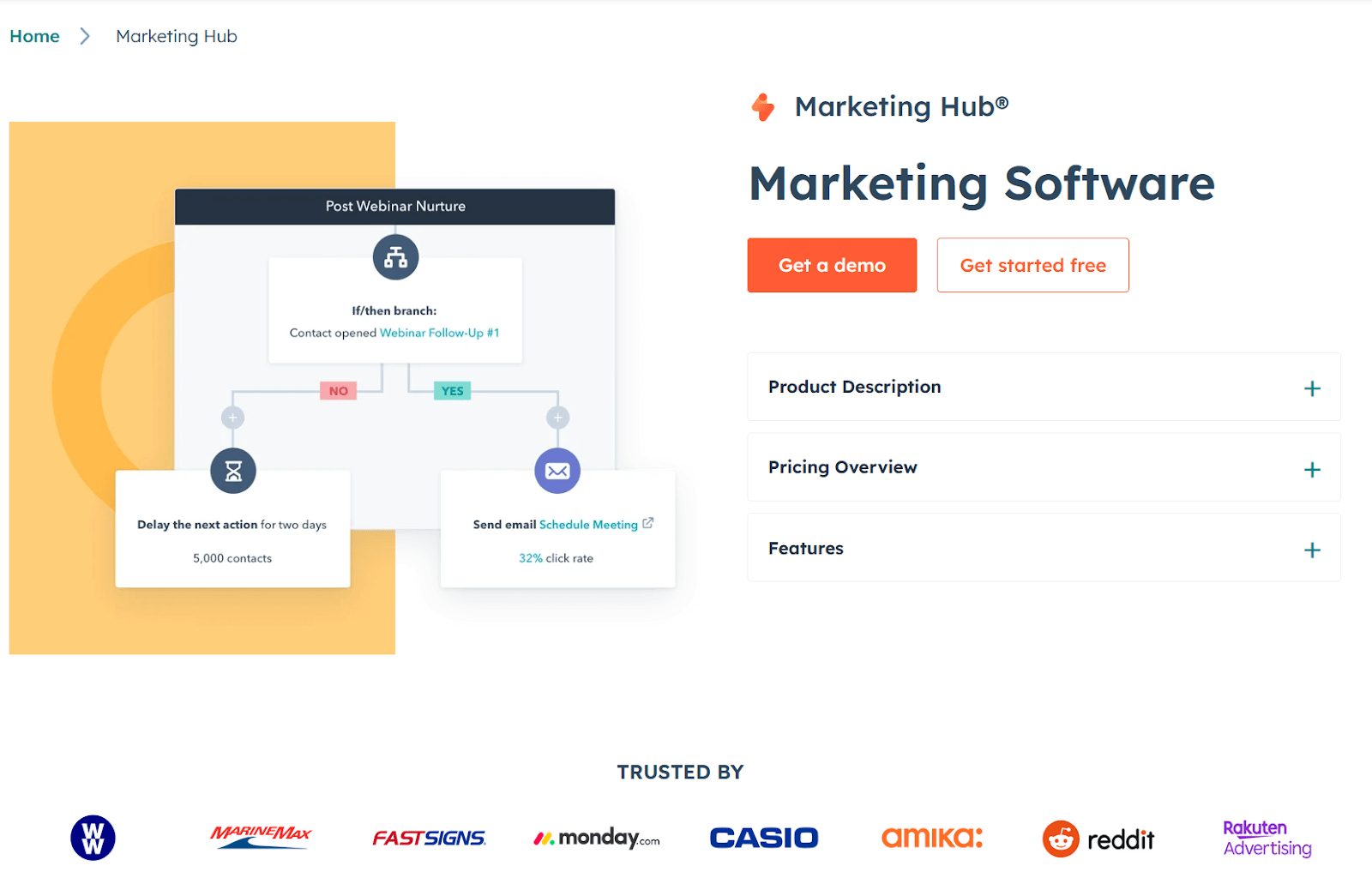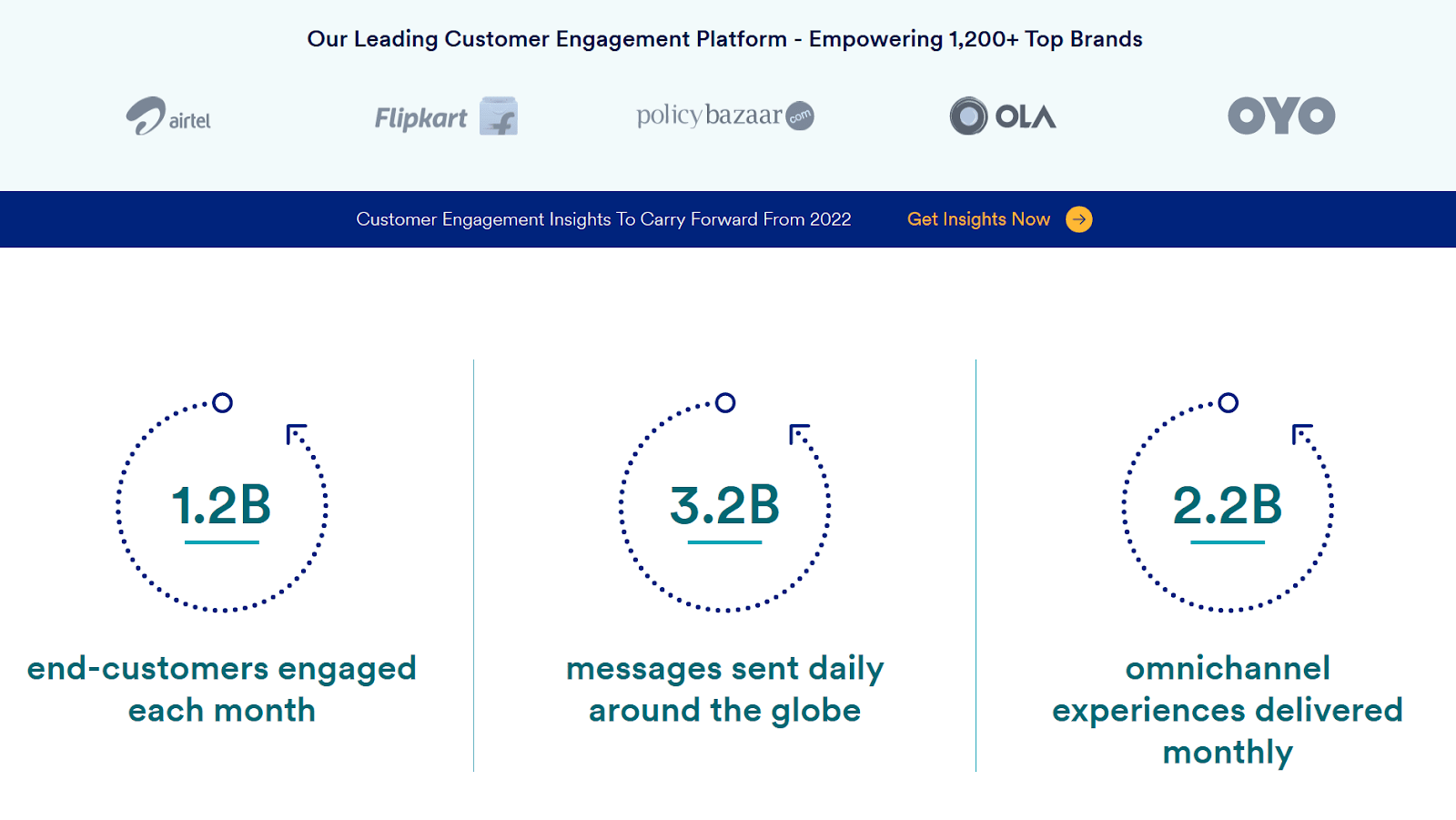Stages of Customer Journey and How You Track Them
A customer’s journey across your funnel is complex and will have many touchpoints. If you are a B2B business, things get even more complicated as multiple decision makers and longer customer journeys are involved.
This is where understanding the various stages of the customer journey and tracking them comes into play. Doing these, not only do you identify qualified prospects with intent but also serve targeted content across different buying stages and improve customer experience.
A thorough understanding of customer journey stages should equate to improving the delivery of customer experience. I’m sure you want to learn about these stages and win over more customers.
However, before we delve into the customer journey stages, let’s start with some basics!
What is a Customer Journey?
The customer journey is the sequence of interactions between a business and a buyer during the purchasing process, encompassing important stages from awareness to post-sales engagement.
The focus on customer experience has substantially increased in recent years, to the extent that it has become a major factor influencing purchase decisions. Understanding the customer journey enables businesses to customize and manage the experiences they provide.
Moreover, comprehending the customer journey helps identify customers who are further along in the sales funnel, displaying purchase intent. By prioritizing these customers, businesses can enhance their experiences. Additionally, customers in earlier stages of the customer journey can be guided towards later stages.
The 5 Stages of Customer Journey

Image Source: techtarget.com
Awareness
In the Awareness stage, potential customers become aware of a product, service, or brand. This can occur through various marketing efforts such as advertisements, social media, word-of-mouth, or content marketing (like the blog you’re reading now).
Customers recognize a need or problem and start researching to understand their options. This stage is about grabbing attention and creating an initial interest in the customer’s mind.
Consideration
During the Consideration stage, customers actively research and evaluate different products or services. They compare features, read reviews, and assess how well each option meets their specific needs.
Businesses need to provide detailed information, comparisons, and expert opinions to help customers make informed decisions. Building trust and credibility are crucial at this stage. Establishing thought leadership yields tremendous benefits at this stage.
Decision
As the research ends, all the stakeholders discuss the ins and outs of the product. Once everyone is convinced, the purchase goes through. Factors like pricing, promotions, warranties, and the overall value proposition influence this decision.
This is often a critical stage and necessitates effective sales and marketing strategies. The aim is simple, make an offer they cannot refuse. Thus, discounts, limited-time offers, complimentary upgrades, etc. can tip the balance in your favor.
Retention
Making a sale isn’t the end of the line. Rather this is where the most important function begins, retention! Retaining customers is tremendously more cost-effective. Thus, post-purchase engagement, customer support, and follow-up communication are vital.
Businesses have to work to ensure that customers have a positive experience with the product or service. This stage aims to build customer loyalty, encouraging repeat purchases and long-term relationships.
Advocacy
As they say, a happy customer is a business’s best asset. The Advocacy stage involves turning happy customers into brand advocates. Such customers are not only loyal but also enthusiastic about the product or service.
They recommend the brand to others, write positive reviews, and spread the word through social media and other channels. For instance, consider Apple users. There’s no customer base as influential as Apple’s. They go above and beyond to promote Apple and its products. In most cases, they would even defend Apple against critics.
Thus, when a business understands the different stages of the customer journey, it can tailor and personalize the customer experience it can offer.
Difference Between Customer Journeys in B2B and B2C
Customer journeys vary greatly between B2B and B2C scenarios. In B2C, a single decision-maker – the end consumer – drives quick sales, often based on emotions and brand appeal.
Conversely, B2B involves multiple decision-makers, leading to longer sales cycles focused on ROI, value and integration with existing systems. B2B strategies rely on detailed content, personalized pitches, and collaborations, while B2C emphasizes mass appeal and online interactions via websites and social media.
Post-purchase, B2B emphasizes ongoing support and training, fostering long-term relationships, whereas B2C concentrates on customer satisfaction, feedback, and loyalty programs.
Additionally, B2B transactions generally involve higher values compared to B2C products and services.
Before You Start Tracking Customer Journeys
Before you start tracking, it is important to note that it is important to not cross the ethical line and uphold data privacy and customer safety. Crossing this line means leaving your business vulnerable to serious lawsuits and severely compromising the future of your firm.
Here’s the right way to implement customer journey tracking.
1. Anonymized Data
Businesses can track customer journeys while ensuring data privacy by collecting and analyzing anonymized data. By removing personally identifiable information, customers’ identities remain protected, addressing concerns about privacy breaches.
2. Transparency and Consent
Want to track customers safely to improve their experience? Why not just ask for their consent? Clear communication about the purpose of data collection and how it benefits customers can alleviate privacy concerns.
3. Data Security Measures
Collecting customer journey data is only half of it. Businesses also need to ensure the data is stored and secured properly to avoid leaks and unauthorized access.
Implementing robust data security measures, such as encryption and secure storage protocols ensures that customer data remains safe.
All in all, as the competition gets fierce, businesses need to improve and deliver exceptional customer experience. Uphold business ethics and customer interests and you will have a productive undertaking tracking customer journeys.
What are the Key Benefits of Customer Journey Tracking?
Simply put, tracking customer journeys supercharges the effectiveness of your sales and marketing activities. We will take a look at some major benefits in detail below.
1. Personalized Customer Experience
Everyone wants special treatment. Thus, when a business already knows about you, your needs and your preferences, the purchase decision becomes quite easy.
Customer journey data allows companies to personalize their marketing strategies, product offerings, and customer service enhancing the overall customer experience which results in improved conversion rates and customer satisfaction.
2. Data-Driven Decision Making
You will no longer be shooting in the dark hoping to convert customers. With customer journey tracking, you will have complete visibility into what works and what doesn’t, for each customer. The scope for optimization is vast and can deliver drastic improvements.
Plus, customer journey data can help you identify qualified prospects (for B2B) and take key decisions to take them further in the funnel.
3. Competitive Advantage
As mentioned earlier, customer experience plays a pivotal role in converting and retaining a customer. Thus, with more insights into customer behavior and expectations, your business can meet and even exceed customer expectations.
Additionally, this knowledge can also help identify emerging trends, needs and expectations in the early stages. Thus, you can adapt and benefit from a significant competitive advantage over other providers in the market.
4. Improved Customer Engagement
Knowing when a customer needs something can be game-changing. Customer journey tracking enables this. Thus, businesses can engage with their customers effectively.
Sending targeted communication, relevant offers and promotions or addressing concerns promptly can be very beneficial. Such a level of effective engagement fosters trust and strengthens the customer-business relationship.
5. Enhanced Customer Support
Imagine knowing about every problem a customer might face and being ready with solutions. Sounds like magic, doesn’t it? This is another powerful thing customer journey tracking enables.
Businesses can anticipate customer issues based on their journey patterns and proactively offer solutions. Thus, issues can be resolved more efficiently, leading to higher customer satisfaction rates.
3 Customer Journey Tracking Tools
Let’s take a look at the best customer journey-tracking tools on the market.
1. Salespanel

Salespanel is a powerful marketing and sales intelligence solution. It tracks visitors across all pages, devices, and domains, providing a comprehensive view of the customer journey. When a visitor lands on your website, Salespanel initially identifies their source. Subsequently, it tracks their interactions across your website and web applications. For B2B visitors, the software identifies their respective workplaces, enabling the identification of accounts for approximately 30-60% of your visitors from the outset. When leads eventually sign up through a form or live chat, Salespanel automatically captures their lead data and enriches their contact information with key personal and firmographic data. Once a lead enters your sales funnel, the product assists with lead scoring, real-time insights, qualification, and notifications, as well as seamless integrations with popular CRM and marketing automation platforms.
Salespanel also enables you to establish different tracking systems to comply with your data regulatory and privacy requirements.
Pros
- Comprehensive tracking
- Lead scoring and qualification
- Real-time insights and notifications
- Easy to use and integrate
- Affordable pricing
Cons
- Reporting features: The reporting features could be more advanced.
- Performance: The software can be slow at times with large websites.
Pricing – Salespanel’s Basic plan starts at $149 a month. They do offer a 14-day free trial.
2. Hubspot Marketing Hub

Marketing tools and HubSpot are almost synonymous in today’s markets. A veteran in the marketing and analytics field, HubSpot has years of experience and expertise to deliver the best marketing solutions.
Thus, it shouldn’t come as a surprise that it has one of the most effective customer journey-tracking solutions on offer.
Pros
- All-in-one marketing platform.
- Detailed insights.
- Excellent customer support.
- Easy to use interface.
- Helpful online resources.
Cons
- Pricing: HubSpot Marketing Hub can be expensive, especially for small businesses.
- Steep learning curve: It has a lot of features, which can make it difficult to learn and use for first-time users.
Pricing – Hubspot’s Professional plan starts at $800 a month. They do offer a free plan with limited capabilities.
3. MoEngage

MoEngage is a customer engagement platform that focuses on driving engagement and building trust through personalization. It offers omnichannel engagement capabilities and powerful analytics and insights.
Thus, with MoEngage, you can reach the right customer, at the right time, with the right communication and the best channel.
Pros
- Comprehensive tracking capabilities.
- Customer journey orchestration.
- Extensive personalization capabilities.
- Excellent automation capabilities.
- A multitude of Integrations.
Cons
- Pricing: MoEngage can be expensive for small businesses.
- Learning curve: MoEngage can be complex to learn and use at times.
- Customer support: Users have reported that customer support isn’t prompt.
Pricing – Paid plans start at $1299 a month. Also offers a free Starter plan with limited tracking capabilities.
Concluding
Managing and delivering the best customer experience is the key to success for businesses in present times. Customer journey tracking can enable this by granting better insights into what the customers need and expect.
Customer journey tracking can be beneficial to your business provided you do it in the right way. Customer journey insight-driven marketing can yield staggering returns.
Sell more, understand your customers’ journey for free!
Sales and Marketing teams spend millions of dollars to bring visitors to your website. But do you track your customer’s journey? Do you know who buys and why?
Around 8% of your website traffic will sign up on your lead forms. What happens to the other 92% of your traffic? Can you identify your visiting accounts? Can you engage and retarget your qualified visitors even if they are not identified?


